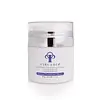What's inside
What's inside
 Key Ingredients
Key Ingredients

 Benefits
Benefits

 Concerns
Concerns

No concerns
 Ingredients Side-by-side
Ingredients Side-by-side

Water
Skin ConditioningHydrogenated Polyisobutene
EmollientCetearyl Alcohol
EmollientGlycerin
HumectantPersea Gratissima Oil
Skin ConditioningOlea Europaea Fruit Oil
MaskingStearyl Alcohol
EmollientBis-PEG/PPG-16/16 PEG/PPG-16/16 Dimethicone
EmollientPalmitoyl Grape Seed Extract
Skin ConditioningCeteareth-20
CleansingMacadamia Ternifolia Seed Oil
EmollientCaprylyl Glycol
EmollientSodium Lauroyl Lactylate
EmulsifyingCaprylic/Capric Triglyceride
MaskingAcrylates/C10-30 Alkyl Acrylate Crosspolymer
Emulsion StabilisingAcetyl Hexapeptide-37
Skin ConditioningPanthenol
Skin ConditioningGlycine Soja Protein
EmulsifyingHexylene Glycol
EmulsifyingTocopheryl Acetate
AntioxidantAnadenanthera Colubrina Bark Extract
HumectantCeramide NP
Skin ConditioningCeramide AP
Skin ConditioningCeramide EOP
Skin ConditioningCholesterol
EmollientPhytosphingosine
Skin ConditioningXanthan Gum
EmulsifyingEthylhexylglycerin
Skin ConditioningCarbomer
Emulsion StabilisingPhenoxyethanol
PreservativePotassium Sorbate
PreservativeBenzyl Alcohol
PerfumingPolysorbate 20
EmulsifyingButylene Glycol
HumectantParfum
MaskingLinalool
PerfumingLimonene
PerfumingWater, Hydrogenated Polyisobutene, Cetearyl Alcohol, Glycerin, Persea Gratissima Oil, Olea Europaea Fruit Oil, Stearyl Alcohol, Bis-PEG/PPG-16/16 PEG/PPG-16/16 Dimethicone, Palmitoyl Grape Seed Extract, Ceteareth-20, Macadamia Ternifolia Seed Oil, Caprylyl Glycol, Sodium Lauroyl Lactylate, Caprylic/Capric Triglyceride, Acrylates/C10-30 Alkyl Acrylate Crosspolymer, Acetyl Hexapeptide-37, Panthenol, Glycine Soja Protein, Hexylene Glycol, Tocopheryl Acetate, Anadenanthera Colubrina Bark Extract, Ceramide NP, Ceramide AP, Ceramide EOP, Cholesterol, Phytosphingosine, Xanthan Gum, Ethylhexylglycerin, Carbomer, Phenoxyethanol, Potassium Sorbate, Benzyl Alcohol, Polysorbate 20, Butylene Glycol, Parfum, Linalool, Limonene
 Reviews
Reviews

Ingredients Explained
These ingredients are found in both products.
Ingredients higher up in an ingredient list are typically present in a larger amount.
Caprylyl Glycol is a humectant and emollient, meaning it attracts and preserves moisture.
It is a common ingredient in many products, especially those designed to hydrate skin. The primary benefits are retaining moisture, skin softening, and promoting a healthy skin barrier.
Though Caprylyl Glycol is an alcohol derived from fatty acids, it is not the kind that can dry out skin.
This ingredient is also used as a preservative to extend the life of products. It has slight antimicrobial properties.
Learn more about Caprylyl GlycolHexylene Glycol is a surfactant. Glycols are a class of alcohols. Hexylene Glycol is a surfactant and emulsifier.
As a surfactant, Hexylene Glycol helps gather dirt and oil on your skin to be washed away.
As an emulsifier, Hexylene Glycol helps keep water and oil together. This prevents them from separating in a product. Hexylene Glycol also thins out the texture of a product by lessening viscosity.
Hexylene Glycol has a small molecular weight.
Learn more about Hexylene GlycolPanthenol is a common ingredient that helps hydrate and soothe the skin. It is found naturally in our skin and hair.
There are two forms of panthenol: D and L.
D-panthenol is also known as dexpanthenol. Most cosmetics use dexpanthenol or a mixture of D and L-panthenol.
Panthenol is famous due to its ability to go deeper into the skin's layers. Using this ingredient has numerous pros (and no cons):
Like hyaluronic acid, panthenol is a humectant. Humectants are able to bind and hold large amounts of water to keep skin hydrated.
This ingredient works well for wound healing. It works by increasing tissue in the wound and helps close open wounds.
Once oxidized, panthenol converts to pantothenic acid. Panthothenic acid is found in all living cells.
This ingredient is also referred to as pro-vitamin B5.
Learn more about PanthenolPhenoxyethanol is a preservative that has germicide, antimicrobial, and aromatic properties. Studies show that phenoxyethanol can prevent microbial growth. By itself, it has a scent that is similar to that of a rose.
It's often used in formulations along with Caprylyl Glycol to preserve the shelf life of products.
Water. It's the most common cosmetic ingredient of all. You'll usually see it at the top of ingredient lists, meaning that it makes up the largest part of the product.
So why is it so popular? Water most often acts as a solvent - this means that it helps dissolve other ingredients into the formulation.
You'll also recognize water as that liquid we all need to stay alive. If you see this, drink a glass of water. Stay hydrated!
Learn more about Water